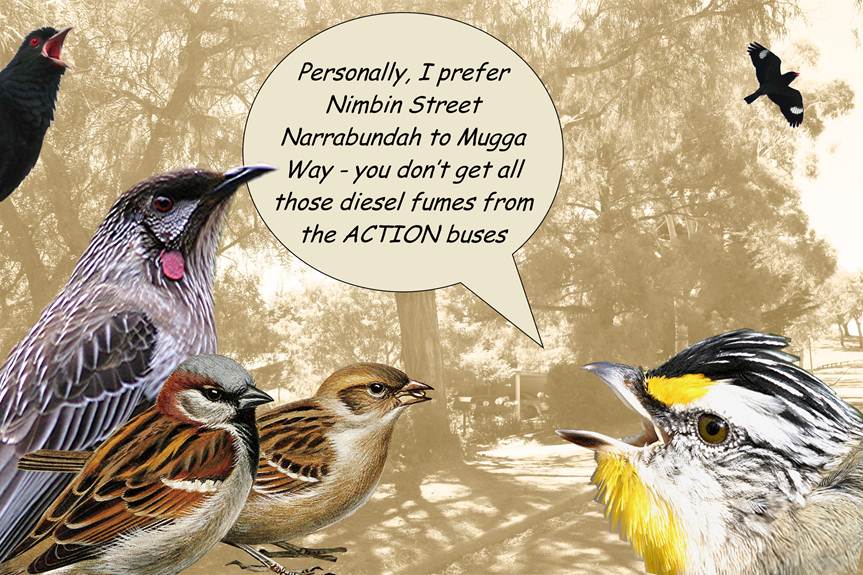Thank you for the pdf Robin. I was struck by the passage: “Socio-economic factors are unlikely to influence birds … however, they may influence urban fauna indirectly through the link between socio-economic profile and vegetation cover.” If large gardens and more trees are not directly influencing factors, I would like to be told a direct one. It is pointed out that in really big cities, as distinct from Queanbeyan and the others studied, people with more money live in the centre where there are less birds.

From: Robin Hide [
Sent: Thursday, 3 January 2013 8:05 AM
To: Canberra Birds
Subject: [canberrabirds] Ornithology Virtual Issue from Wiley
Some COG members might be interested in some of the avian articles available (free downloads- at least some*) from this "virtual issue" from Wiley-
Zoology & Animal Science: Ornithology Virtual Issue
This virtual issue collects together key papers on the theme of ornithology from across our range of zoology and ecology journals, read them free online for a limited time.
http://onlinelibrary.wiley.com/subject/code/000120/homepage/ornithology_virtual_issue.htm
*Not all of the articles are available as free access (or their limited time may have lapsed?) - for instance these two:
Biological Reviews
Challenging claims in the study of migratory birds and climate change
- Endre Knudsen1, et al....cle first published online: 13 APR 2011
Recent shifts in phenology in response to climate change are well established but often poorly understood. Many animals integrate climate change across a spatially and temporally dispersed annual life cycle, and effects are modulated by ecological interactions, evolutionary change and endogenous control mechanisms. Here we assess and discuss key statements emerging from the rapidly developing study of changing spring phenology in migratory birds. These well-studied organisms have been instrumental for understanding climate-change effects, but research is developing rapidly and there is a need to attack the big issues rather than risking affirmative science. Although we agree poorly on the support for most claims, agreement regarding the knowledge basis enables consensus regarding broad patterns and likely causes. Empirical data needed for disentangling mechanisms are still scarce, and consequences at a population level and on community composition remain unclear. With increasing knowledge, the overall support (‘consensus view’) for a claim increased and between-researcher variability in support (‘expert opinions') decreased, indicating the importance of assessing and communicating the knowledge basis. A proper integration across biological disciplines seems essential for the field's transition from affirming patterns to understanding mechanisms and making robust predictions regarding future consequences of shifting phenologies.
Austral Ecology
Environmental and socio-economic factors related to urban bird communities
- GARY W. LUCK1,
- LISA T. SMALLBONE1,
- KATHRYN J. SHEFFIELD2
Article first published online: 12 APR 2012
DOI: 10.1111/j.1442-9993.2012.02383.x
Urban fauna communities may be strongly influenced by environmental and socio-economic factors, but the relative importance of these factors is poorly known. Most research on urban fauna has been conducted in large cities and it is unclear if the patterns found in these locations coincide with those from smaller human settlements. We examined the relative importance of environmental and socio-economic factors in explaining variation in urban bird communities across 72 neighbourhoods in 18 regional towns in south-eastern Australia. Native bird species richness varied from 6 to 32 across neighbourhoods and was higher in neighbourhoods with more nectar-rich plants. Variation in bird species diversity across neighbourhoods was also strongly positively related to the density of nectar-rich plants, but was higher also in neighbourhoods with higher socio-economic status (reflecting higher levels of disposal income, education and home ownership). The density of native birds across neighbourhoods per season varied from 1 to 15 birds per hectare and was lower in neighbourhoods with a greater cover of impervious surfaces. The density of exotic birds (introduced to Australia) per season also varied across neighbourhoods (0–13 birds per hectare) and was lower in neighbourhoods with more nectar-rich plants and higher in neighbourhoods with greater impervious surface cover. Our results demonstrated that the vegetation characteristics of household gardens, along streetscapes and in urban parklands had a strong influence on the richness and diversity of urban bird communities. The density of native and exotic birds varied primarily in response to changes in the built environment (measured through impervious surface cover). Socio-economic factors had relatively little direct influence on urban birds, but neighbourhood socio-economics may influence bird communities indirectly through the positive relationship between socio-economic status and vegetation cover recorded in our study area
When I queried Wiley about their availablility, they sent me pdfs of these two - if anyone wants a copy of either of these please send me an email.
Robin Hide

